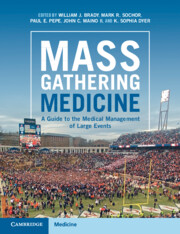1092 results
Sperlingite, (H2O)K(Mn2+Fe3+)(Al2Ti)(PO4)4[O(OH)][(H2O)9(OH)]⋅4H2O, a new paulkerrite-group mineral, from the Hagendorf-Süd pegmatite, Oberpfalz, Bavaria, Germany.
-
- Journal:
- Mineralogical Magazine / Accepted manuscript
- Published online by Cambridge University Press:
- 20 May 2024, pp. 1-27
-
- Article
-
- You have access
- Export citation
Fast tracking tool selection for sustainability decisions
-
- Journal:
- Global Sustainability / Volume 7 / 2024
- Published online by Cambridge University Press:
- 30 April 2024, e24
-
- Article
-
- You have access
- Open access
- HTML
- Export citation
Electrophysiological correlates of inhibitory control in children: Relations with prenatal maternal risk factors and child psychopathology
-
- Journal:
- Development and Psychopathology , First View
- Published online by Cambridge University Press:
- 24 April 2024, pp. 1-14
-
- Article
-
- You have access
- Open access
- HTML
- Export citation
Contributors
-
- Book:
- Mass Gathering Medicine
- Published online:
- 11 April 2024
- Print publication:
- 18 April 2024, pp ix-xii
-
- Chapter
- Export citation
Preface
-
- Book:
- Mass Gathering Medicine
- Published online:
- 11 April 2024
- Print publication:
- 18 April 2024, pp xv-xvi
-
- Chapter
- Export citation
Appendix 2 - Suggested Medications: Infield Medical Center
- from Chapter 13 - Mass Gathering Events: Motor Sport Events
-
- Book:
- Mass Gathering Medicine
- Published online:
- 11 April 2024
- Print publication:
- 18 April 2024, pp 195-195
-
- Chapter
- Export citation
Dedication
-
- Book:
- Mass Gathering Medicine
- Published online:
- 11 April 2024
- Print publication:
- 18 April 2024, pp v-vi
-
- Chapter
- Export citation
Appendix 3 - NASCAR Recommended Equipment for Infield Medical Center from NASCAR 2012 Medical Verification Form
- from Chapter 13 - Mass Gathering Events: Motor Sport Events
-
- Book:
- Mass Gathering Medicine
- Published online:
- 11 April 2024
- Print publication:
- 18 April 2024, pp 196-198
-
- Chapter
- Export citation
Appendix 1 - Motor-Sports Concussion Guidelines
- from Chapter 13 - Mass Gathering Events: Motor Sport Events
-
- Book:
- Mass Gathering Medicine
- Published online:
- 11 April 2024
- Print publication:
- 18 April 2024, pp 194-194
-
- Chapter
- Export citation
Foreword
-
- Book:
- Mass Gathering Medicine
- Published online:
- 11 April 2024
- Print publication:
- 18 April 2024, pp xiii-xiv
-
- Chapter
- Export citation
Index
-
- Book:
- Mass Gathering Medicine
- Published online:
- 11 April 2024
- Print publication:
- 18 April 2024, pp 406-418
-
- Chapter
- Export citation
Copyright page
-
- Book:
- Mass Gathering Medicine
- Published online:
- 11 April 2024
- Print publication:
- 18 April 2024, pp iv-iv
-
- Chapter
- Export citation
Contents
-
- Book:
- Mass Gathering Medicine
- Published online:
- 11 April 2024
- Print publication:
- 18 April 2024, pp vii-viii
-
- Chapter
- Export citation

Mass Gathering Medicine
- A Guide to the Medical Management of Large Events
-
- Published online:
- 11 April 2024
- Print publication:
- 18 April 2024
Detection of occult thrombosis in individuals with Fontan circulation by cardiac MRI
-
- Journal:
- Cardiology in the Young , First View
- Published online by Cambridge University Press:
- 20 March 2024, pp. 1-6
-
- Article
-
- You have access
- Open access
- HTML
- Export citation
Head and Neck Cancer: United Kingdom National Multidisciplinary Guidelines, Sixth Edition
-
- Journal:
- The Journal of Laryngology & Otology / Volume 138 / Issue S1 / April 2024
- Published online by Cambridge University Press:
- 14 March 2024, pp. S1-S224
- Print publication:
- April 2024
-
- Article
-
- You have access
- Open access
- HTML
- Export citation
Near-source passive sampling for monitoring viral outbreaks within a university residential setting
-
- Journal:
- Epidemiology & Infection / Volume 152 / 2024
- Published online by Cambridge University Press:
- 08 February 2024, e31
-
- Article
-
- You have access
- Open access
- HTML
- Export citation
Sorption of Isoxaflutole and DKN on Organoclays
-
- Journal:
- Clays and Clay Minerals / Volume 52 / Issue 3 / June 2004
- Published online by Cambridge University Press:
- 01 January 2024, pp. 341-349
-
- Article
- Export citation
Castor Toxin Adsorption to Clay Minerals
-
- Journal:
- Clays and Clay Minerals / Volume 53 / Issue 3 / June 2005
- Published online by Cambridge University Press:
- 01 January 2024, pp. 268-277
-
- Article
- Export citation
4 Risk Factor and Biomarker Correlates of FLAIR White Matter Hyperintensities in Former American Football Players
-
- Journal:
- Journal of the International Neuropsychological Society / Volume 29 / Issue s1 / November 2023
- Published online by Cambridge University Press:
- 21 December 2023, pp. 608-610
-
- Article
-
- You have access
- Export citation



